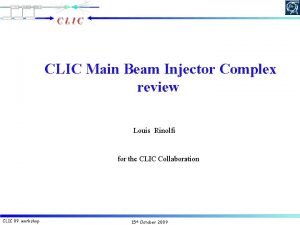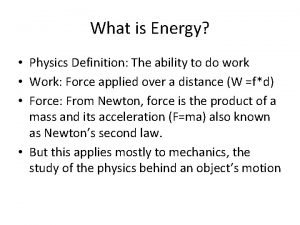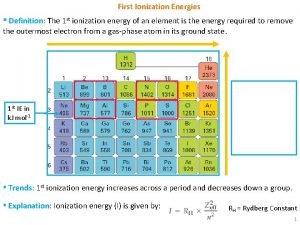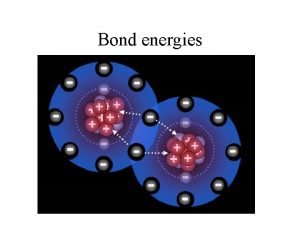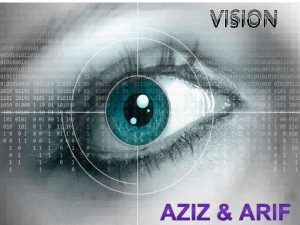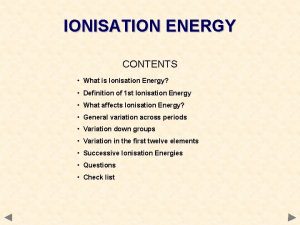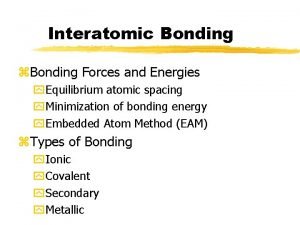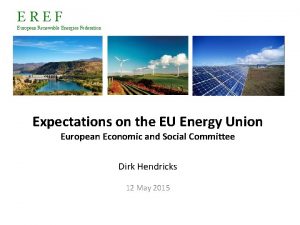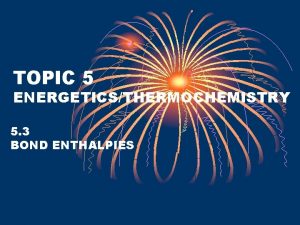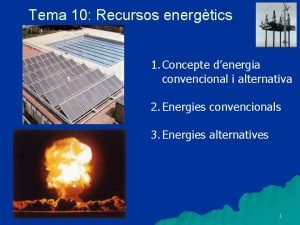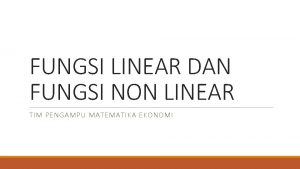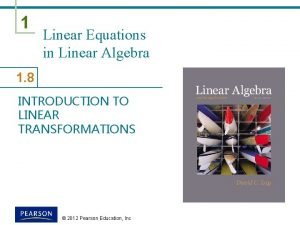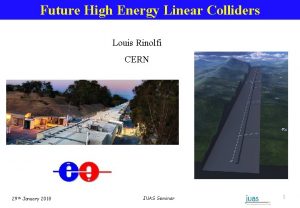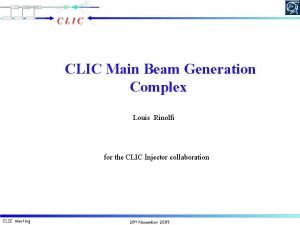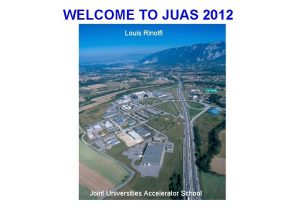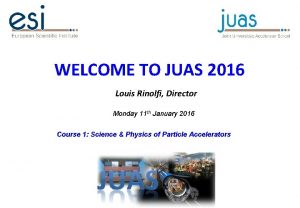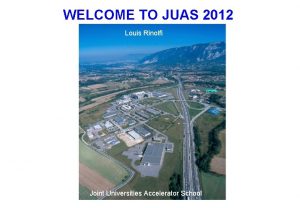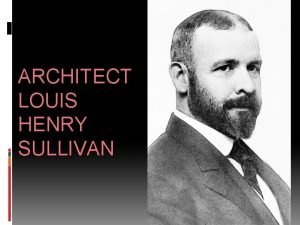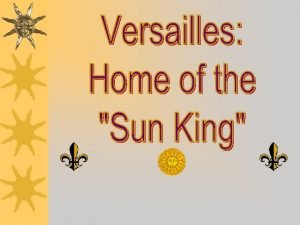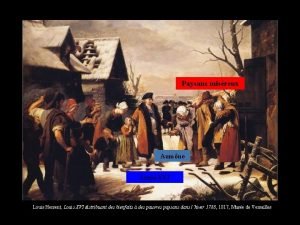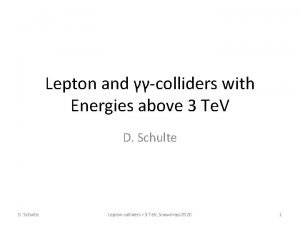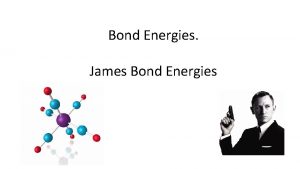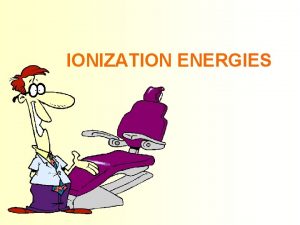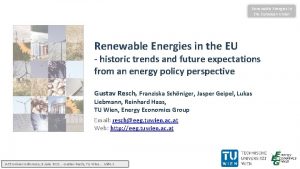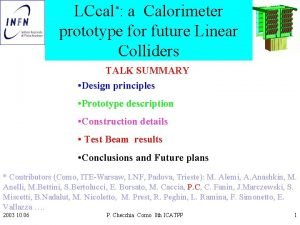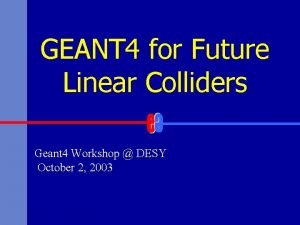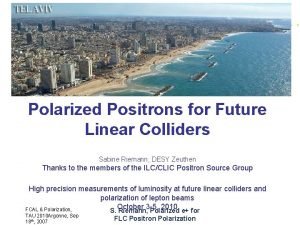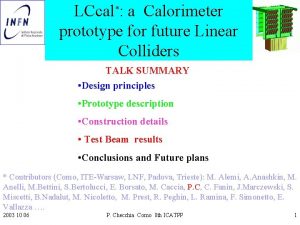Future High Energies Linear Colliders Louis Rinolfi 27































![Main beam parameters Parameter Symbol [unit] ILC CLIC LPA PWFA CMS energy Ecm [Ge. Main beam parameters Parameter Symbol [unit] ILC CLIC LPA PWFA CMS energy Ecm [Ge.](https://slidetodoc.com/presentation_image_h2/1e7b0c35d8d7328687de0176c3767571/image-32.jpg)






- Slides: 38

Future High Energies Linear Colliders Louis Rinolfi 27 th January 2016 JUAS Seminar

A citation to start “Viki” Wiesskopf, Director General of CERN 1961 -1965 wrote: “ There are three kinds of physicists, namely the machine builders, the experimental physicists, and theoretical physicists. If we compare this with the discovery of America, the machine builders correspond to captains and ship builders who really developed the techniques at that time. The experimentalists were those fellows on the ships who sailed to the other side of the world and then landed on the new islands and wrote down what they saw. The theoretical physicists are those who stayed behind in Madrid and told Columbus that he was going to land in India. ” 27 th January 2016 JUAS Seminar

General physics context today LHC announced on 4 th July 2012 the discovery of a Higgs boson at 126 Ge. V Peter Higgs With the discovery of a Higgs boson, after one century of superb Physics, the Standard Model is now complete. Do we need other high energy colliders ? If the answer is “yes”, at which Energy and which Luminosity ? 27 th January 2016 JUAS Seminar

Concept of Energy E = mc 2 27 th January 2016 JUAS Seminar

Concept of Luminosity The number of events for a particular type of event is given by: Number of events = L x sevent is the probability of producing a particular event L is a measure of the total number of interactions The unit of the cross-section (sevent) is the barn (1 barn = 10 -28 m 2) 1 mb = 10 -31 m 2 1 mb = 10 -34 m 2 1 nb = 10 -37 m 2 1 pb = 10 -40 m 2 1 fb = 10 -43 m 2 If the cross-section to produce a given event is 1 fb then we would need 1 fb-1 of data to get 1 event!! L=N 27 th January 2016 events /s event JUAS Seminar

Linear colliders major parameters Energy (center of mass) Ecm = 2 Ffill Llinac GRF Me. V m MV/m Hz Luminosity L = nb N+ N- frep 4 p sx sy cm cm-2 s-1 Ffill = Filling factor of the Linac; nb = number of bunches; 27 th January 2016 Llinac = Length of the linac; N = number of particles per bunch; GRF = accelerating gradient sx, sy = beam size parameters JUAS Seminar

Linear Collider Challenges e+ target e. With a reduced power consumption and a minimum cost Reach the highest collision energy Reach the highest luminosity BDS = Beam Delivery System RTML = Return To Main Linac 27 th January 2016 JUAS Seminar

Where to look at ? • How do we build the optimal machine given a physics scenario (partly seen at LHC ? ) • • • Higgs physics (SM and non-SM) Top SUSY Higgs strong interactions Extra dimensions 27 th January 2016 JUAS Seminar

Three ways of research 27 th January 2016 JUAS Seminar

SLC (Stanford Linear Collider) 2 experiments: MARK II, SLD Energy: 92 Ge. V Peak Luminosity: 2 x 1030 cm-2 s-1 Operation: 1989 -1998 The only Linear Collider who was running with a beam up to now 27 th January 2016 JUAS Seminar

Brief history of CLIC (Compact Linear Collider e+ e-) 1985: CLIC = CERN Linear Collider CLIC Note 1: “Some implications for future accelerators” by J. D. Lawson => first CLIC Note => 6 Linear colliders studies (TESLA, SBLC, JLC, NLC, VLEPP, CLIC) 2004: International Technology Recommendation Panel selects the Superconducting RF technology (TESLA based) versus room temperature technology (JLC/NLC based) => ILC at 1. 3 GHz for the Te. V scale and CLIC study at 30 GHz continues for the multi-Te. V scale 2006: CERN Council Strategy group (Lisbon July 2006) 2007: Major parameters changes: 2012 : July: Announce at LHC of particle consistent with long-sought Higgs boson CERN Council Strategy group for Particle Physics (Krakow September 2012) Publication of CLIC - CDR (Conceptual Design Report) 2016: CTF 3 shut-down at the end of the year 27 th January 2016 30 GHz => 12 GHz and 150 MV/m => 100 MV/m JUAS Seminar more than 30 years !!! 1995: CLIC = Compact Linear Collider

CLIC Test Facility drive beam 12 Recently installed 2 -beam acceleration module in CTF 3 (according to latest CLIC design) Lucie Linssen, March 5 th 2015 27 th January 2016 JUAS Seminar main beam

CLIC Layout (3 Te. V) e+ e- Drive Beam Generation Complex Main Beam Generation Complex 27 th January 2016 JUAS Seminar

CLIC Tunnel layout 27 th January 2016 JUAS Seminar

CLIC staging parameters With the discovery of the Higgs boson at 126 Ge. V, the stage 1 is now at 380 Ge. V (instead of 500 Ge. V) 27 th January 2016 JUAS Seminar

27 th January 2016 JUAS Seminar 16

A tremendous amount of challenging parameters Accelerating gradient ( G = 100 MV/m) Very low break down rate in the accelerating cavities (BDR < 10 -7) Beam emittance production and preservation (ge n = 5 nm. rad at Damping ring exit) Ground motion and stability requirements Positron flux ( 1. 1 1014 e+/s => 20 times more than the SLC machine produced) Beam size at IP (sy = 1 nm) Power consumption ( ~ 600 MW) Cost (several billions of €, $, CHF, …. . ) + many others; none will be discussed in this seminar; only the beam size at IP is illustrated in the next slide 27 th January 2016 JUAS Seminar

Challenges at the Interaction Point: beam size Vertical spot size at IP is 1 nm Stability requirements (> 4 Hz) for a 2% loss in luminosity Magnet Horizontal jitter Vertical jitter Linac (2600 quads) 14 nm 1. 3 nm Final Focus (2 quads) QD 0 4 nm 0. 15 nm 27 th January 2016 JUAS Seminar H 2 O molecule

ILC (International Linear Collider) e+ e- 27 th January 2016 JUAS Seminar

ILC accelerator overview ► High gradient acceleration with super-conducting accelerator. ► High luminosity is obtained with the high aspect ratio beam made up with Damping ring and final focus. L = 1. 8 1034 cm-2 s-1 ► Polarized electron. ► Potential polarization of positron. 27 th January 2016 G = 31. 5 MV/m 3. 9 1014 e+/s JUAS Seminar

ILC parameters Parameter Symbol ILC Unit Center of mass energy Ecm 500 Ge. V Main Linac RF Frequency f. RF 1. 3 GHz Luminosity L 2 1034 cm-2 s-1 L 99% 1 1034 cm-2 s-1 Linac repetition rate frep 5 Hz No. of particles / bunch Nb 20 109 No. of bunches / pulse kb 1312 Overall two linac length llinac 22 km Proposed site length ltot 31 km Beam power / beam Pb 10. 8 MW ηwp-rf 9. 4 % Total site AC power Ptot 230 MW Transverse horizontal emittance γεx 8000 nm rad Transverse vertical emittance γεy 40 nm rad Horizontal IP beam size before pinch σ*x 640 nm Vertical IP beam size before pinch σ*y 5. 7 nm Beamstrahlung energy loss δB 2. 4 % Luminosity (in 1% of energy) Wall-plug power to beam efficiency 27 th January 2016 JUAS Seminar

ILC in Japan ? Kitakami site 27 th January 2016 JUAS Seminar

A tremendous amount of challenging parameters Accelerating gradient in SC cavities ( G = 31 MV/m) Beam emittance production and preservation (ge n = 10 nm. rad at Damping ring exit) Ground motion and stability requirements Positron flux ( 3. 9 104 e+/s => 70 times more than the SLC machine produced) Beam size at IP (sy = 6 nm) Power consumption ( ~ 230 MW) Cost (several billions of €, $, CHF, …. . ) + many others; none will be discussed in this seminar; only the e+ source is illustrated in the next slide 27 th January 2016 JUAS Seminar

Challenge to produce e+ Driven by > 125 Ge. V => The main electron beam should go through a SC helical undulator to produce polarized photons Advantage => Polarized positrons (30 to 60 %) are produced => Powerful tool for Physics 27 th January 2016 JUAS Seminar

Some signal at 750 Ge. V ? Search for di-photon resonances in ATLAS and CMS Small excesses in both experiments around 750 Ge. V could be statistical fluctuations or first hints of a new (broad) particle need more data ! ATLAS Local �� Global �� Mass (Ge. V) �� (Ge. V) 3. 6 2. 0 750 NWA 27 th January 2016 CMS 8 Te. V 8+13 Te. V 2. 6 <1. 2 760 ~25 3 <1. 7 750 ~25 JUAS Seminar 25

gg collider from CLIC • • Based on e-e- collider But collide electron beam with laser beam just before the IP (at small angle α) Hard backscattered photons move almost in direction of initial electron (angle ~1/γ) Photons collide g IP g eons t pho 27 th January 2016 JUAS Seminar

Other possible future linear colliders LPA = Laser Plasma Accelerator PWFA = Plasma Wake Field Accelerator DLA = Dielectric Laser Accelerator JUAS Seminar on Laser Plasma Accelerator Wednesday 3 rd February 2016 by Ralph Abmann / DESY 27 th January 2016 JUAS Seminar

Laser-driven Plasma Accelerator 27 th January 2016 JUAS Seminar

Plasma Linear Collider 27 th January 2016 JUAS Seminar

One LPA project 27 th January 2016 JUAS Seminar

PWFA as Linear Collider Concept for PWFA-LC layout for 1 Te. V. Based on earlier work from 2009 by Raubenheimer et al. E. Adli et al. , “A beam driven Plasma Wake-Field Linear Collider”, CSS 2013 and ar. Xiv: 1308. 1145 27 th January 2016 JUAS Seminar
![Main beam parameters Parameter Symbol unit ILC CLIC LPA PWFA CMS energy Ecm Ge Main beam parameters Parameter Symbol [unit] ILC CLIC LPA PWFA CMS energy Ecm [Ge.](https://slidetodoc.com/presentation_image_h2/1e7b0c35d8d7328687de0176c3767571/image-32.jpg)
Main beam parameters Parameter Symbol [unit] ILC CLIC LPA PWFA CMS energy Ecm [Ge. V] 500 3000 1000 3000 Luminosity L [1034 cm-2 s-1] 1. 8 6 2. 0 6. 3 Lum. in peak L 0. 01 [1034 cm-2 s-1] 1 2 (0. 74) 2. 5 Beam power [MW] 10. 5 28 9. 6 48 Eff. gradient G [MV/m] 21 80 5000 1000 Particl. /bunch N [109] 20 3. 72 4 10 Bunch length σz [μm] 300 44 1 20 IP beam size σx, y [nm/nm] 474/6 40/1 10/10 194/1. 1 Emittances εx, y [nm] 104/35 660/20 100/100 104/35 Bunches/train nb 1312 1 1 Bunch dist. Δz [ns] 554 0. 5 66. 7 x 103 105 Rep. rate fr [Hz] 5 50 15 x 103 104 27 th January 2016 JUAS Seminar

Dielectric Laser Acceleration (DLA concept) The energy of ILC in 500 m All challenges are not discussed here 27 th January 2016 JUAS Seminar

Dreams of today 27 th January 2016 JUAS Seminar

Future ? LHC continues to investigate what physics is behind the Higgs boson discovery and what energy scale should be considered. Future LHC results would establish the scientific case for future High Energy Colliders 27 th January 2016 JUAS Seminar

Many fundamental questions remain open What is the origin of the mass of the particles ? Why there is no antimatter in the space ? What was the state of the matter just after the Big-Bang ? Why our existing models explain only 4% of the Univers estimated mass ? And many more …… Future is very exciting for the Science and for young scientists 27 th January 2016 JUAS Seminar 36

Conclusion Remember what wrote Wiesskopf, (Director General of CERN 1961 -1965) JUAS students are the future machine builders …. for future high energy linear colliders and other particle accelerators ! 27 th January 2016 JUAS Seminar

Acknowledgements Some slides have been taken from Erik Adli, Ralph Assmann, Fabiola Gianotti, Phil Burrows, Paul Emma, R. J. England, Andrea Latina, W. P. Leemans, Tsunehiko Omori, John Osborne, Daniel Schulte, Frank Tecker, Carsten Welsch CLIC workshop 2016 LCWS workshop 2015 EAAC workshop 2015 27 th January 2016 JUAS Seminar
 Louis rinolfi
Louis rinolfi Future perfect continuous tense sentences
Future perfect continuous tense sentences Future simple continuous perfect
Future simple continuous perfect Louis vuitton vl
Louis vuitton vl Physics what is energy
Physics what is energy Ionization energy chart
Ionization energy chart Is bond breaking endothermic
Is bond breaking endothermic Negative image
Negative image Successive ionisation energies of calcium
Successive ionisation energies of calcium Bonding forces and energies
Bonding forces and energies European renewable energies federation
European renewable energies federation Bond enthalpy reactants minus products
Bond enthalpy reactants minus products Meter installation/removal
Meter installation/removal Four energies
Four energies Energies convencionals
Energies convencionals Future perfect
Future perfect Present tense to past tense
Present tense to past tense Future continuous.
Future continuous. Future nurse future midwife e learning
Future nurse future midwife e learning Present continuous interrupted
Present continuous interrupted Present continuous for future activities
Present continuous for future activities Future continuous and future perfect
Future continuous and future perfect Future plans and finished future actions
Future plans and finished future actions Perfect future continuous tense
Perfect future continuous tense 1 2 3 kondicional u engleskom jeziku
1 2 3 kondicional u engleskom jeziku Gearing up for the future (senior high school)
Gearing up for the future (senior high school) Linear regression vs multiple regression
Linear regression vs multiple regression Persamaan non linier metode biseksi
Persamaan non linier metode biseksi Linear and nonlinear text
Linear and nonlinear text Nonlinear narrative examples
Nonlinear narrative examples Soal dan jawaban metode newton raphson
Soal dan jawaban metode newton raphson Linear pipeline processors
Linear pipeline processors Disadvantages of multimedia
Disadvantages of multimedia A left linear grammar is always
A left linear grammar is always Perbedaan fungsi linear dan non linear
Perbedaan fungsi linear dan non linear Pengertian fungsi non linear
Pengertian fungsi non linear Linearly independent
Linearly independent Linear algebra linear transformation
Linear algebra linear transformation Dwi koordinat
Dwi koordinat
